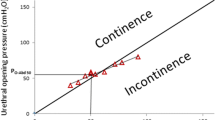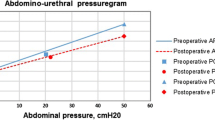Abstract
The aim of this study was to determine the characteristics of women who meet the criteria for intrinsic sphincteric deficiency (ISD) on maximum urethral closure pressure (MUCP) but not on leak point pressure (LPP) measurement. We performed a cross-sectional chart review of every patient who underwent multichannel, microtransducer urodynamic testing in our center between 1994 and 1996 (n=423). From this population we culled a sub-population of women who fit into one of the following two groups: women with no evidence of ISD on MUCP or LPP and women with evidence of ISD on MUCP only. Logistic regression was used to identify independent predictors of group membership. Increasing age (>60.5 years) and a positive supine empty stress test were the only independent predictors of membership in the group of women with ISD on MUCP only. Knowledge of these risk factors may help clinicians in choosing appropriate pre-operative testing.


Similar content being viewed by others
Abbreviations
- ISD :
-
Intrinsic sphincteric deficiency
- LPP :
-
Leak point pressure
- MUCP :
-
Maximum urethral closure pressure
References
Blaivas JG, Appell RA, Fantl JA, et al (1997) Definition and classification of urinary incontinence: recommendations of the urodynamic society. Neurourol Urodyn 16:149–151
McGuire EJ, Fitzpatrick CC, Wan J, et al (1993) Clinical assessment of urethral sphincter function. J Urol 150:1452–1454
Sand PK, Bowen LW, Panganiban R, Ostergard DR (1987) The low pressure urethra as a factor in failed retropubic urethropexy. Obstet Gynecol 69:399–402
Bowen LW, Sand PK, Ostergard DR, Franti CE (1989) Unsuccessful Burch retropubic urethropexy: a case-controlled urodynamic study. Am J Obstet Gynecol 160:452–458
Culligan PJ, Goldberg R, Sand PK (2003) A randomized controlled trial comparing a modified Burch procedure and suburethral sling: long-term follow-up. Int Urogynecol J 14:229–233
Swift SE, Ostergard DR (1995) A comparison of stress leak-point pressure and maximal urethral closure pressure in patients with genuine stress incontinence (1995) Obstet Gynecol 85:704–708
Bump RC, Coates KW, Cundiff GW, Harris RL Weidner AC (1997) Diagnosing intrinsic sphincteric deficiency: comparing urethral closure pressure, urethral axis, and Valsalva leak point pressures. Am J Obstet Gynecol 177:303–310
Abrams P, Cardozo L, Fall M, et al (2002) The standardization of terminology of lower urinary tract function: report from the standardisation sub-committee of the International Continence Society. Neurourol Urodyn 21:167–178
Tabachnick BG, Fiddell LS (2001) Using multivariate statistics, 4th edn. Allyn & Bacon, Needham
Haab F, Zimmern PE, Leach GE (1996) Female stress urinary incontinence due to intrinsic sphincteric deficiency: recognition and management. J Urol 156:3–17
Wilson TS, Lemack GE, Zimmern PE (2003) Management of intrinsic sphincteric deficiency in women. J Urol 169:1662–1669
Bent AE (1999) Selection of treatment for patients with stress incontinence. Int Urogynecol J 10:213–214
Culligan PJ, Goldberg RP, Blackhurst DW, Sasso D, Koduri S, Sand PK (2001) Comparison of microtransducer and fiberoptic catheters for urodynamic studies. Obstet Gynecol 98:253–257
Boyles SH, Weber AM, Meyn L (2003) Procedures for urinary incontinence in the United States, 1979–1997. Am J Obstet Gynecol 189:70–75
Nilsson CG, Kuuva N (2001) The tension-free vaginal tape procedure is successful in the majority of women with indications for surgical treatment of urinary stress incontinence. BJOG 108:414–419
McLennan MT, Bent AE (1998) Supine empty stress test as a predictor of low valsalva leak point pressure. Neurourol Urodyn 17:121–127
Hsu THS, Rackley RR, Appell RA (1999) The supine empty stress test: a simple method to detect intrinsic urethral sphincter dysfunction. J Urol 162:460–463
Miklos JR, Sze EHM, Karram MM (1995) A critical appraisal of methods of measuring leak point pressures in women with stress incontinence. Obstet Gynecol 86:349–352
Author information
Authors and Affiliations
Corresponding author
Additional information
Editorial Comment: Valsalva leak point pressures and maximum urethral closure pressures are two different tests that can be used to evaluate and quantify urethral sphincteric function. The authors performed a cross-sectional study to determine the characteristics of women whose diagnosis of ISD would be missed based on an abnormal MUCP defined as <20 cm H20 if only a LPP was assessed. They found that of 305 patients with a normal LPP defined as >60 cm H20, 288 patients also had a normal MUCP (Group A) compared to 17 patients who had an abnormal MUCP (Group B). In comparing 18 patients characteristics, they found that age greater than 60 years and a positive supine empty stress test were independent risk factors for membership in Group B. It is known that both MUCP and LPP are fraught with variables making each difficult to standardize and validate. One could question whether a MUCP with a cutoff <20 cm can truly be used to define ISD. This brings up a related criticism described as a limitation by the authors—mainly that LPP were measured only at a bladder volume of 150 cc. Perhaps if the measurements were repeated at a larger bladder volume, there would have been an even greater correlation between MUCP and LPP. More needs to be done in the future to better standardize tests used to evaluate urethral function. As the authors mentioned, however, with the success of suburethal slings for all types of stress incontinence, perhaps this is a moot point.
Rights and permissions
About this article
Cite this article
Murphy, M., Culligan, P.J., Graham, C.A. et al. Is the leak point pressure alone an accurate indicator of intrinsic sphincteric deficiency?. Int Urogynecol J 15, 294–297 (2004). https://doi.org/10.1007/s00192-004-1154-8
Received:
Accepted:
Published:
Issue Date:
DOI: https://doi.org/10.1007/s00192-004-1154-8




